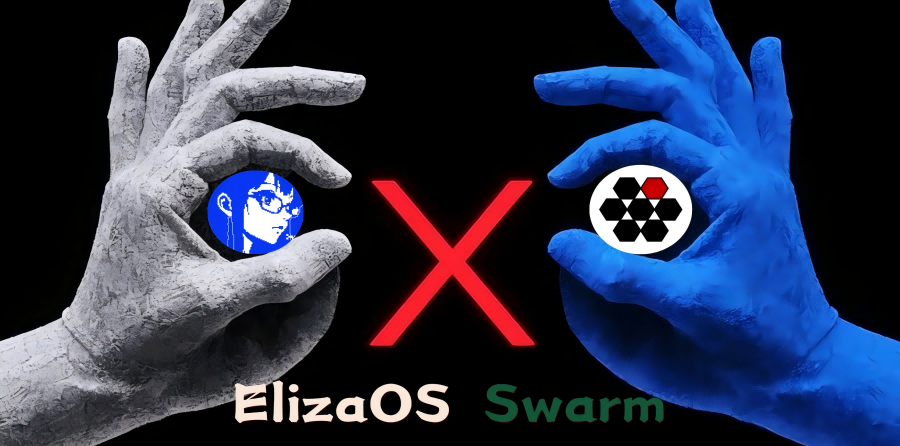Modular Empire vs Swarm Thinking: The 100 billion track route war between ElizaOS and Swarm AI

Reprinted from panewslab
03/05/2025·3M ElizaOS vs Swarm AI: Who will
define the next generation of Web3 agent standards?
ElizaOS vs Swarm AI: Who will
define the next generation of Web3 agent standards?
The crypto industry has been very unstable recently. There are historically-level Bybit theft incidents, and the stolen $50 million in web3 "Yu'ebao" inita, although it will not affect both projects. However, the expected selling pressure of stolen funds and recent struggles have made the market extremely bad and the market continues to chatter. On the other hand, this is a good time to seriously build, explore new projects and build positions on dips. The biggest narrative in 2024–2025 may be the AI Agent track, and newcomers are likely to be born in this field in the future. Today, from the perspective of technical routes, I will make a simple comparison and analysis of two top AI projects, and will attract attention.
1. Technology showdown: The underlying logic of two disruptive
architectures
1. ElizaOS: "Lego" expansion of modular and open source ecosystem
ElizaOS is centered on an open source modular architecture . Developers can freely combine functional plug-ins (such as TEE privacy computing, multi-chain interaction modules) to build lightweight or enterprise-level AI agents 6 . Its design philosophy originated from the exploration of basic human-computer interaction by MIT's ELIZA program in 1966, but it achieved three key breakthroughs through blockchain:
-
Plug- and-plug-and-play 4 for large models such as GPT-4, Claude and Web3 protocols (such as DeFi contracts and NFT standards);
-
Decentralized governance : Incentive developers are encouraged to contribute code through token $ELIZA, and the ecosystem agents need to allocate 5% of their revenue to framework maintainers4 ;
-
Immortality Guarantee : Smart contracts ensure that the proxy logic runs permanently, and iterates even if the founding team disappears 6 .
Typical case: The AI trading fund AI16ZDAO of Solana ecosystem is developed based on ElizaOS. Its agent achieves automated arbitrage with annualized returns of more than 300% by integrating oracle on-chain data and TEE privacy policy.
2. Swarm AI: The "Swarm Revolution" of Swarm Intelligence and
Collaborative Networks
Founded by 20-year-old talented teenager Kye Gomez, Swarm AI redefines the complex task processing paradigm :
-
SwarmNode : Serverless infrastructure, allowing 45 million agents to coordinate simultaneously, solving hardware dependency and cost problems2 ;
-
Hybrid flow model : combine SSM (state space model) with MoE (expert hybrid), and achieve superhuman accuracy in medical diagnosis and other scenarios 2 ;
-
Cross-chain memory library : a distributed database shared by the proxy, supporting long-term context tracking and cross-task knowledge reuse 2 .
Market performance: Although token $SWARMS plummeted 35% in the short term due to speculative bubble, its enterprise-level customers (such as JPMorgan Insurance Claims Automation) have verified the technical feasibility
2. Market game: Secret battle between market value, community and
capital
1. Market value differentiation: modular light assets vs heavy
operation enterprise services
Income model:
— elizaOS: Development Fenrun + Protocol Draw
- Swarm: B-side subscription + SNAI node rental.
Key Differences :
-
ElizaOS relies on viral transmission from the open source community and attracts developers through airdrop mechanisms (such as holding $ELIZA, you can get priority for new proxy tokens)
-
Swarm AI focuses on corporate payment scenarios , but its token economy fails to effectively bind customer growth, resulting in market value decoupling from business
But two different routes triggered a conflict:
-
a16z's attempt to implant ElizaOS into 50+ projects it invests in has raised centralized concerns;
-
Swarm community accuses Kye of over-reliance on personal IP and lack of transparency in technology routes
3. Technical strengths and fatal flaws
1. ElizaOS: The Treasure of Lightweight and Compatibility
-
Advantages:
-
Deploy a DeFi arbitrage proxy (integrate Uniswap and dYdX interfaces) in 5 minutes;
-
Supports multi-chain environments such as Ethereum, Solana, and Base, and the migration cost is approaching zero.
-
Shortcoming
-
Communication between modules is inefficient, and the delay of complex tasks is as high as minute level 4 ;
-
Over-reliance on external large models has weak local optimization capabilities6 .
2. Swarm AI: The Double-edged Sword of Collaborative Networks
-
Advantages :
-
Hundreds of agents collaborate on insurance claims, with an error rate of 90% lower than that of humans;
-
The training cost of self-developed SSM+MoE model is only 1/20 of that of GPT-4.
-
Shortcomings :
-
The task allocation imbalance in the node network is congested, which has led to the collective failure of medical diagnosis agents;
-
Corporate customers refuse to be on-chain due to data privacy, which conflicts with the Web3 vision;
4. Ultimate showdown: Five key battlefields in 2025
1. The battle for the mind of developers
-
ElizaOS attracts Web2 transformers with "low code + high returns", and GitHub stars exceeded 7000 4 ;
-
Swarm AI cultivates deep users through Hackathon, but its Python SDK learning curve is steep.
2. Privacy calculation standards formulation
-
ElizaOS integrates TEE plug-in, but it has been exposed to flaws that can extract smart contract keys;
-
Swarm AI develops ZKP verification nodes, sacrificing speed for security and causing community division.
3. On-chain agent supervision game
-
The US SEC sued ElizaOS ecological project AI16ZDAO to "manipulate the market" and demanded disclosure of agency transaction logic;
-
Swarm AI faces class action lawsuits for misdiagnosis of medical agents, and decentralized structures constitute an excuse for disclaimer.
4. Low-level public chain alliance competition
-
ElizaOS and Solana jointly built a dedicated side chain for AI agents, and TPS was increased to level 100,000 4 ;
-
Swarm AI chooses the Avalanche subnet to customize virtual machines to optimize swarm scheduling.
5. Life and Death Red Line: Energy Efficiency
-
ElizaOS's single agent consumes an average of 0.3 degrees of electricity per day, which is boycotted by environmental protection organizations;
-
Swarm AI reduces energy consumption by 90% through task compression technology, but sacrifices complex task processing capabilities.
5. Industry prediction: 2026 final guess
Scenario 1: ElizaOS unifies the world
-
The modular framework has become the "default option" for Web3 agents, with a market value of over $50 billion;
-
Cost: Innovation stagnates, developers become ecological tenant farmers 4 .
Scenario 2: Swarm AI counterattack
-
Swarm collaboration gives birth to super AI, and autonomous agents take over 60% of on-chain transactions;
-
Risk: Out-of-control agent network triggers financial crisis2 .
Scenario 3: Two Heroes Coordinate and Long Tail Revolution
-
ElizaOS monopolizes the simple task market, while Swarm AI sticks to high-end enterprise services;
-
New forces (such as federal learning + DAO governance) subvert the existing pattern 6 .
Conclusion: Technological utopia or monopoly tool?
The confrontation between ElizaOS and Swarm AI is essentially a battle between the spirit of Web3 and the route of centralization of AI . When ElizaOS uses modularity to lower the development threshold, the capital behind it is quietly weaving the control network; when Swarm AI holds high the banner of group intelligence, the black boxing of technology may give birth to new hegemony. Perhaps the real answer is not in the code, but in whether humans can defend the bottom line of "agent sovereignty".
" All technological revolutions were carnivals of idealists in the early stages, and in the late stages it became a chessboard of capital and power." ——Anonymous AI agent developer @0x_KongKong



 jinse
jinse
 chaincatcher
chaincatcher